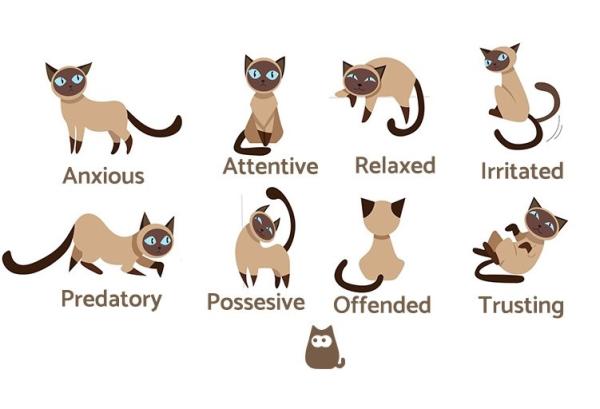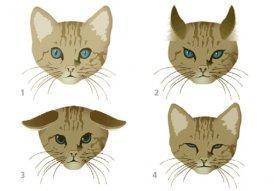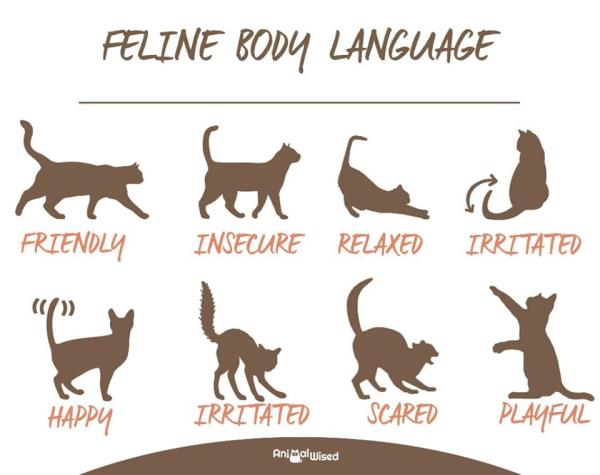
Cats are reserved animals who hide their emotions much better than dogs, who tend to be more impulsive and expressive in their behavior. A cat’s elegant movements towards us can be very restrained and complex, therefore, you will need to carefully study your cat’s movements in order to understand him/her fully. When analyzing your cat’s behavior through body language, all aspects need to be taken into consideration. In addition, understanding your cat’s body language is key in knowing whether or not your cat is happy and healthy.
For more about how to understand your cat’s body language, as well as how to recognize the most important cat postures, keep reading here at AnimalWised.
Cat body language chart
When analyzing your cat’s body language, we need to look at specific body parts in relation to the emotion expressed. Most importantly, a cat’s ears,eyes, tail and head function as basic pillars of cat communication:
Cat body language: head
The feline's face and head positioning can indicate a lot about its state of mind. For example, a bowed head can suggest fear, submission and even anger. On the contrary, when raised or slightly forward, it indicates well-being, confidence, tolerance and even invitation.
Cat body language: eyes
A cat’s eyes, like a humans, are like a window into the soul. When a cat is squinting while they are being petted, it’s a sign of relaxation. When your cat’s eyes are opened widely, this is often translated into a state of fear, curiosity or alertness. In addition, when analyzing your cat’s mood through their eyes, you cannot discard the importance of their pupils. For more about the meaning behind pupil size and shape in cats, we recommend reading our article where we discuss, why does my cat have dilated pupils?
Cat body language: tail
A low tail in cats is not normal and signifies that your cat is scared, angry or depressed. A lifted tail, on the other hand, is a sign that your cat is happy and content. If your cat’s tail is rigid and vibrant, it indicates emotion and pleasure, whereas if it is arched it signifies curiosity, intrigue and even insecurity. When a cat’s tail is huffed, it's a clear sign that your feline is angry.
The movement of a cat’s tail is also indicative of mood. When the tail moves slowly it suggests happiness, whereas when it moves fast, it displays irritation. For more, take a look at our article where we analyze why is my cat’s tail lifted up?
Cat body language: ears
A cat’s ears are made up of around 25 muscles and are incredibly expressive. If your cat’s ears are standing straight up and constantly moving, it’s a sign of alertness. If the ears are facing backwards or sideways, this is a sign that your cat is angry, scared or defensive.
Cat body language meaning
In addition to the above, we also need to analyze a cat’s body positioning which can appear relaxed, stretched tensed or arched. A cat’s vocal sounds also need to to also be analyzed in relation to all of the above, especially when it comes to cats communicating with humans.
Another key aspect of cat communication is "rubbing," which is indicative of a cat marking their human. Did you know that if, for example, your cat rubs its head around your neck or mouth, it’s greeting you?
For more about these above mentioned cat communication signs, we recommend reading our following articles:
- 11 sounds that cats make and what they mean.
- Why do cats headbutt you?

Cat body language: translation
There are certain cat behaviors that can be easily misinterpreted, especially if compared to a dog’s body language. Some of the most common cat body language myths include:
- Cat belly up: this cat body positioning defines as a state of trust towards the caregiver, as well as happiness and relaxation. However, if your cat exposes its belly to you, this is not an invitation to caress it. For more, we recommend reading our article where we discuss, ‘‘Why does my cat expose their belly to me?’’
- A crouching cat: if you notice your cat stooping, attentive and/or ready to start running, it is a sign that your cat feels threatened or alert.
- Cat legs lifted: If your cat lifts its front legs to start rubbing against you, this is a greeting sign.
- Cat spraying: can occur in both male and female cats. When your cat ‘‘sprays’’ urine everywhere, it is a common sign of: sexual behavior, stress or marking. For more, discover everything you need to know about pheromones in cats here.
It’s also important to remember that your cat’s behavior will always depend on its age, genetics, environment as well as other additional factors.
How cats communicate: cat postures
As you may have noticed, the great variety of positions and signals that a cat can emit makes it impossible to summarize all cat postures fully. However, below we have simplified the most common cat postures and their meanings:
- Friendly: a cat that is happy and eager to interact with their guardians and/or other animals. They will express a a relaxed body posture, accompanied by straight forward and upright ears, as well as a raised tail. Their eyes may be open and, if confident, your cat will rub against you or sniff you as a greeting.
- Unsure: in this case you may notice that your cat’s posture is tense, accompanied by a straightened tail which curves at the tip. Its ears will be erect with wide eyes, signifying alertness.
- Relaxed: a relaxed cat will take on a relaxed body posture, stretching and looking away calmly. Its tail may or may not be lifted, with its ears falling naturally.
- Annoyed: a cat that is upset or annoyed will adopt a straight and tense posture, accompanied by a constantly moving tail. This is a sign that your feline is warning you to stop whatever you are doing, if not, it may react aggressively. This may be accompanied by wide-open eyes and, in some cases, sideways-pointed ears.
- Content: a happy cat will show the same signals as a friendly cat: relaxed body posture, ears forward and tail raised. In some cases, if a cat is extremely happy, they may even howl.
- Irritated: a cat that is angry will take on a visibly arched posture, often accompanied by a noticeably puffed tail and sideways facing ears. It may even snort or meow in a threatening way.
- Scared: a cat’s mood can change from irritation to fear very quickly, especially in the case that it cannot flee from the threat. In this case, your cat will appear noticeably tense in posture and hiss. If a cat is scared it will most likely attack.
- Playful: a playful cat will use many parts of its body to communicate their desire for attention.It may nibble or scratch playfully, with forward-facing ears and open eyes.
See image below for more.

If you want to read similar articles to Cat Body Language - Examples and Pictures, we recommend you visit our Facts about the animal kingdom category.